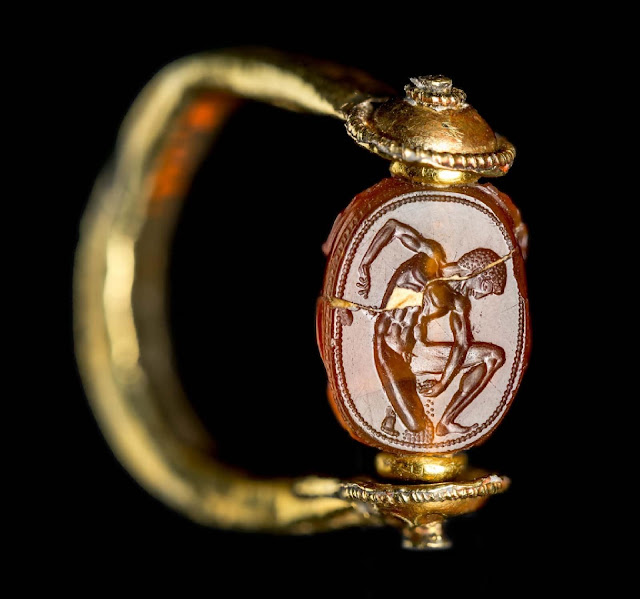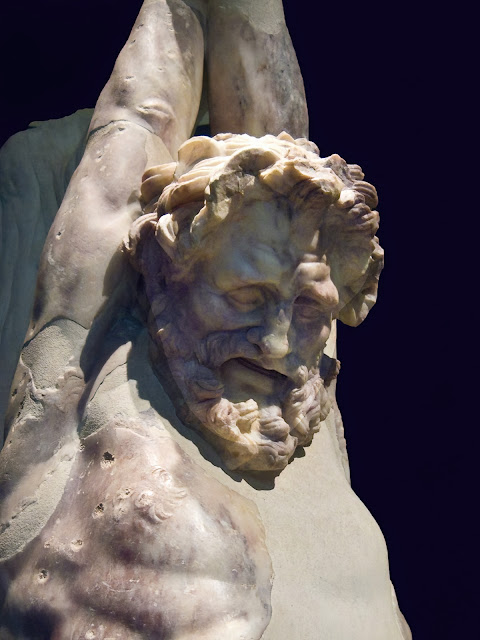According to Greco-Roman myth, the mortal virgin Kallisto (also spelled Callisto), according to Hesiod the daughter of King Lycaon of Arcadia, spent her time in the Arcadian Mountains of Greece as a favorite hunting companion of Artemis, goddess of the hunt and childbirth. Like all of Artemis' nymph companions, Kallisto had vowed to remain chaste. The king of the Greek gods, Zeus, was attracted to Kallisto (when was Zeus never attracted to all of the voluptuous females cavorting around him?) and seduced her by disguising himself as Artemis, which resulted in the birth of a son, Arkas, who gave his name to the area of Greece known as Arcadia. Artemis, angered at Kallisto's betrayal, (or, according to another version, Zeus's wife Hera, enraged with jealousy) changed Kallisto into a bear. (Yes, it's another example of the rape victim being punished for male misbehavior!)
Sixteen years later, her now almost grown son, Arcas, encountered the transformed Kallisto while hunting in the forest. Just as Arcas was about to kill his own mother with his javelin, Zeus (Jupiter) averted the tragedy by placing mother and son amongst the stars as Ursa Major (called Arktos, the "Bear", by Greeks),and Ursa Minor, respectively.
Artemis Kalliste was worshiped in Athens in a shrine which lay outside the Dipylon gate, by the side of the road to the Academy but no inscriptions dated earlier than the 3rd century BCE have been found. Her worship is a little surprising since her story is essentially based on acknowledgement of female homosexuality which itself is hardly mentioned in ancient Greek literature. Only two poets, Sappho and Alcman, a 7th century BCE male Spartan poet, discuss attraction between young women in rather ambiguous language. Despite Sappho's notoriety as a lesbian, only one fragment of Sappho's poetry, Sappho 94, contains a clear mention of female homosexual acts and Sappho herself was said to have been a lover of Alcaeus of Mytilene, a male lyric poet from Lesbos.
In the rigidly patriarchal world of Roman society the mention of female homoeroticism was even more rare. Although homoerotic themes are introduced to Latin literature during a period of increasing Greek influence on Roman culture in the 2nd century BCE, the Romans did not idealize "eros" between freeborn male citizens of equal social status, whether there was a difference of age or not. Such female relations, according to the Roman poet Ovid, were "unheard-of" and "a desire known to no one."
Ovid recounted the tale of Kallisto in Book 2 of "Metamorphoses" but focused clearly on the disguised male-female aspect, vividly describing her violent rape and subsequent "punishment." Wall paintings from a Pompeian brothel next to the Suburban Baths are the only known examples of Roman art depicting sexual congress between women and maybe simply used to emphasize the "forbidden" nature of activities promoted within.
Although references to sex between women are infrequent in the Roman literature of the Republic and early Principate, scholars point to a couple of spells in the Greek Magical Papyri as well as love spells, medical writing, texts on astrology and the interpretation of dreams, that attest to the existence of individual women in Roman-ruled provinces in the later Imperial period who fell in love with members of the same sex as evidence the practice was not socially or legally expunged, though.
In my research for this post, I also came across an interesting analysis of Ovid's version of the Kalissto myth as an example of female censorship. You can read it here:
Like Daphne's transformation into a laurel tree to escape Apollo's embrace, Kalissto's moment of transformation into a bear was a popular theme in classical art. We see that on this small chous or wine jug in the collection of the J. Paul Getty Museum. On the front of the jug, Kallisto sits on a rock covered with animal skins. Willowy trees surround her, creating a woodland setting. Kallisto already has the bear's pointed ears, hairy arms, and paws. She wears hunting boots and her hunting spears are propped against the rock at the left. A male hunter is shown to the left of Kallisto, perhaps drawing back in surprise. On the right, Hermes appears to lift Kallisto's child Arkas from the ground. The messenger god wears his traditional costume of a traveling hat and cloak. His special wand, the kerykeion, rests against a stone marker behind him. Hermes is going to transport the soon-to-be-orphaned baby to his own mother, Maia, who will raise Arkas on Mount Kyllene in Arcadia.
Apulian Red-Figure Chous (Shape 3), about 360 BCE Terracotta, attributed to Near the Black Fury Group (Greek (Apulian) active in the early 300s BCE. Hermes appears to lift Kallisto's child Arkas from the ground. The messenger god wears his traditional costume of a traveling hat and cloak. His special wand, the kerykeion, rests against a stone marker behind him. Hermes is going to transport the soon-to-be-orphaned baby to his own mother, Maia, who will raise Arkas on Mount Kyllene in Arcadia. Image courtesy of the J. Paul Getty Museum.



















































